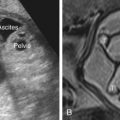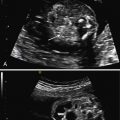- Mert Ozan Bahtiyar
- Carole Gravino

The crown-rump length is a measurement of the length of human fetuses from the top of the crown to the bottom of the rump. It is used to estimate gestational age.

Transvaginal ultrasound and sagittal long-axis view of the endocervical canal. Both the internal os and the external os are well visualized. The cervical length is measured from the internal os to the external os along the endocervical canal.

Sagittal view of the uterus with an anterior (Ant) placenta.

Sagittal view of the uterus showing a posterior (Post) placenta.

Normal umbilical cord insertion into the placenta.

Fetal umbilical cord insertion site. The umbilical arteries emerge caudally—originating at the iliac arteries and coursing along the margin of the urinary bladder. The umbilical vein proceeds cephalad and joins the fetal portal circulation. 3V, Three-vessel.

Transverse view of the umbilical cord. The umbilical cord is composed of a vein and two smaller arteries.

Transverse view of the fetal abdomen and the umbilical cord insertion site showing integrity of the central abdominal wall.

Four-chamber view of the fetal heart at 12 weeks of gestation.

Interventricular septum at 12 weeks of gestation.

Left ventricular outflow at 12 weeks of gestation. LVOT, Left ventricular outflow tract.

Three-vessel view shown by color Doppler at 12 weeks of gestation.

Aortic arch (Ao Arch) at 12 weeks of gestation.

Four-chamber view obtained with a transverse axial view through the fetal thorax. This view provides information on the size of the heart and its chambers; the pulmonary venous connections to the atrial segment; the morphology of the ventricles; the type of atrioventricular (AV) connection; and the integrity of the atrial, AV, and ventricular septa.

Four-chamber view with the fetus in the left decubitus position. The interventricular septum is clearly visualized and appears intact.

The left ventricular outflow tract (LVOT) view is initially obtained with the ventricular septum horizontal to the transducer in the four-chamber view followed by clockwise or counterclockwise rotation of the transducer. The LVOT view also shows the left ventricular inlet with the anterior leaflet of the mitral valve demarcating both the inlet and the outflow tract.

The right ventricular outflow tract (RVOT) view is obtained by starting from the four-chamber view and sliding the transducer toward the fetal head. The RVOT leads to the main pulmonary artery traveling superiorly and posteriorly. Ao, Aorta; Asc Ao, ascending aorta; PA, main pulmonary artery; R PA, right pulmonary artery; RV, right ventricle.

Three-vessel view (3VV) is obtained by sliding the transduced further toward the fetal head after visualization of RVOT. Ao , Aorta; DA, ductus arteriosus; PA , pulmonary artery; SVC , superior vena cava.

Sagittal view of the aortic arch. The aortic arch gives rise to the right innominate or brachiocephalic artery, the left common carotid artery, and the left subclavian artery.

Parasagittal view of the ductal arch. The ductal arch appears as a hockey stick–type structure with no branching head vessels.

Sagittal view of the inferior vena cava and superior vena cava, which are draining into the right atrium.

Stay updated, free articles. Join our Telegram channel

Full access? Get Clinical Tree








